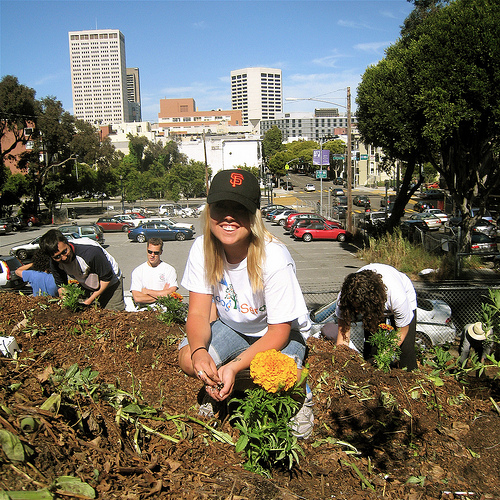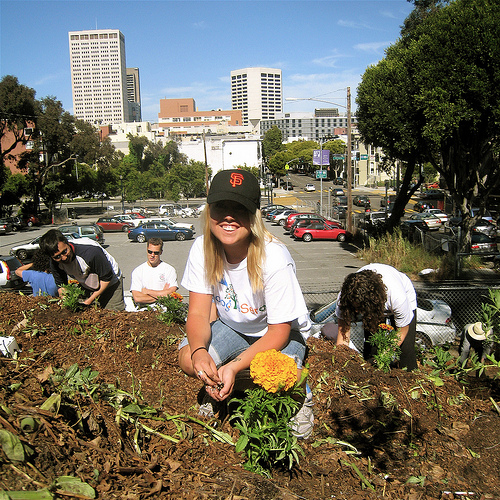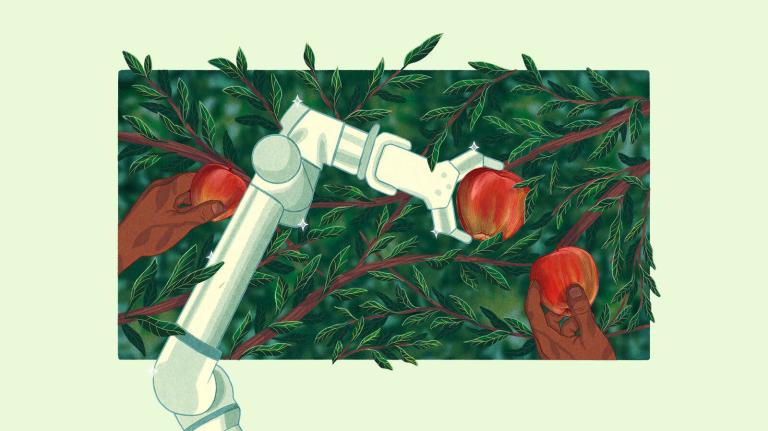 Volunteers participate in a soil remediation project at Hayes Valley Farm in San FranciscoPhoto: Zoe KrollAs someone who works on urban agricultural policy, I’m often asked, “Is city-grown food safe?” The question comes from aspiring urban gardeners and concerned eaters alike. And it seems to stem from both a fear of the known and a fear of the unknown.
Volunteers participate in a soil remediation project at Hayes Valley Farm in San FranciscoPhoto: Zoe KrollAs someone who works on urban agricultural policy, I’m often asked, “Is city-grown food safe?” The question comes from aspiring urban gardeners and concerned eaters alike. And it seems to stem from both a fear of the known and a fear of the unknown.
First, the fear of the known: Common urban contaminants include lead, arsenic, and other heavy metals leaked into soil from old paint, leaded gasoline, modern car exhaust, and industrial land-use. These metals are responsible for a whole host of maladies. Heavy exposure to lead, for example, can harm the nervous system and result in other developmental disabilities, especially in children.
In San Francisco, where I work, a recent study of garden soils confirmed the presence of residual lead in many parts of the city. Similar studies have taken place or are in the works in Minnesota, Chicago, and Indianapolis. They all show considerable evidence of lead in urban soil.
Though we know it’s present, we don’t know the best way to gauge the risk of this lead-contaminated soil. The San Francisco Department of Public Health recently issued guidelines warning that any garden soil containing lead at more than 80 parts per million poses a risk to children. Young kids have an unfortunate habit of ingesting and inhaling all sorts of things, so oral or nasal exposure to lead-contaminated soil is a very real potential danger to their health. But the guidance included a side note underscoring just how confused regulatory agencies are about this exposure risk:
Note that US Environmental Protection Agency (EPA) and California Department of Public Health (CDPH) use 400 ppm or greater of lead in bare soil as their definition of a lead in soil hazard and the CalEPA State Water Resources Control Board (SWRCB) uses 200 ppm or greater of lead for their definition of clearance prior to land use development. Neither of those values is based on the prevention of significant health effects to children [as opposed to adults].
Which leads to the fear of the unknown: Neither the EPA nor the San Francisco Department of Public Health can provide clear guidelines regarding the danger of eating food grown in soil with elevated levels of lead. Scientists aren’t sure about the uptake of toxins in plants, or how much they can transmit to our stomachs. And there’s just as much confusion about the risk of other known toxins besides lead: As the EPA’s Brownfield program recently noted, even when we analyze identified pollutants with understood health impacts, we end up with more questions than answers. With so many questions, many people react emotionally to this general fear of the unknown. The thought process goes something like this: “Food grows in dirt. Dirt is dirty. So city dirt must be really dirty.”
But should we be more concerned about city-grown food than rural-grown food? I don’t think so. First of all, the same highways full of car exhaust that run through our cities run through our rural areas. And while rural areas don’t have the polluting legacy of urban manufacturing industries, they have industrial toxins of their own. Pesticides — including previously-approved-but-now-banned varieties — are prime examples. Another area of concern is biosolids: We routinely take treated sewage from cities and apply it on agricultural fields throughout the country, bringing with it many of the chemicals, including pharmaceuticals, that we flush down our toilets, sinks, and other city drains. How much that affects the food we eat is not clear.
Considering all those factors, perhaps we shouldn’t assume that rural soil is always safer: There are sites within both urban and rural areas that are clean and those that are heavily polluted. Baltimore is considering requiring urban farmers to test their soil; should rural farmers be required to do likewise? Or perhaps the fear of soil toxins in our food supply is greater than the actual risk. Certainly the risk to children who eat soil is different than the risk their parents face from eating the same vegetables grown in that same soil. What tests should we use to gauge those dangers?
Though I don’t have the answers to these questions, I’m heartened when someone asks me about the safety of city-grown food because it shows the true promise of urban agriculture. That promise lies not in the potential to feed ourselves wholly from within our cities, but rather in using the small amount that is grown nearby to connect us with our larger food system. We need to ask more questions of our food supply, both urban and rural. We also need to call on our government agencies, universities, and others to help us answer these questions. In the meantime, I’ll continue eating food grown in the city.



